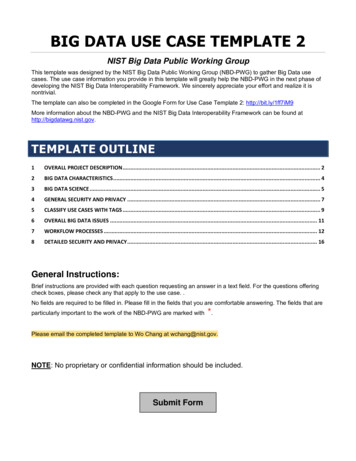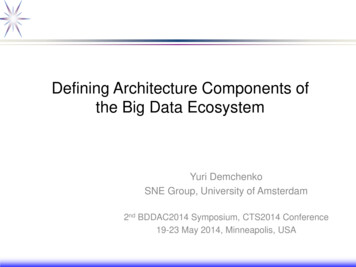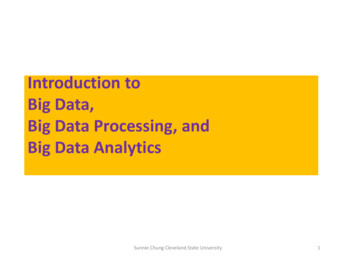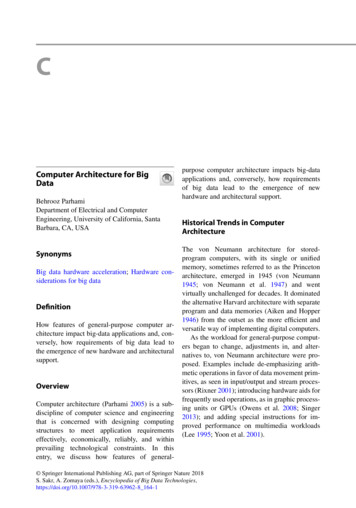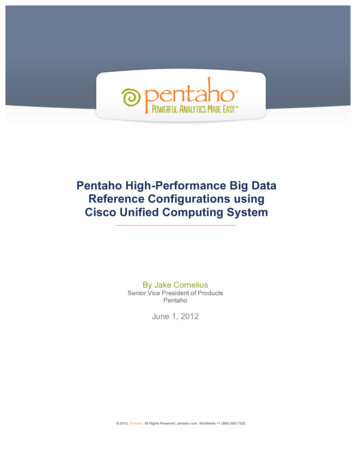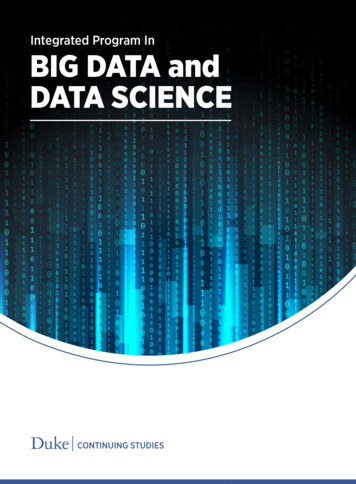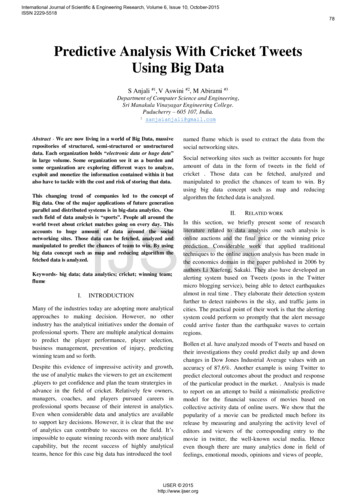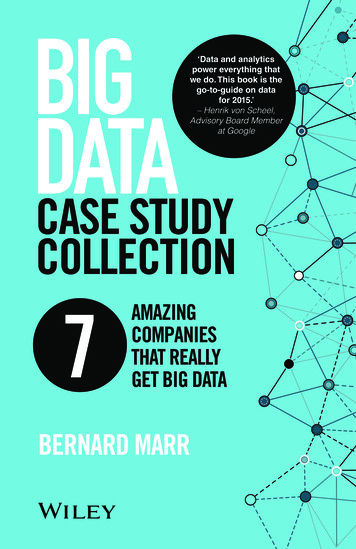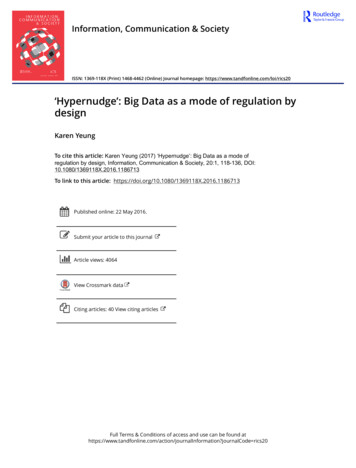
Transcription
Information, Communication & SocietyISSN: 1369-118X (Print) 1468-4462 (Online) Journal homepage: e’: Big Data as a mode of regulation bydesignKaren YeungTo cite this article: Karen Yeung (2017) ‘Hypernudge’: Big Data as a mode ofregulation by design, Information, Communication & Society, 20:1, 118-136, DOI:10.1080/1369118X.2016.1186713To link to this article: shed online: 22 May 2016.Submit your article to this journalArticle views: 4064View Crossmark dataCiting articles: 40 View citing articlesFull Terms & Conditions of access and use can be found ation?journalCode rics20
INFORMATION, COMMUNICATION & SOCIETY, 2017VOL. 20, NO. 1, 186713‘Hypernudge’: Big Data as a mode of regulation by designKaren Yeunga,baCentre for Technology, Ethics, Law & Society, The Dickson Poon School of Law, King’s College London,London, UK; bMelbourne Law School, Melbourne, AustraliaABSTRACTARTICLE HISTORYThis paper draws on regulatory governance scholarship to arguethat the analytic phenomenon currently known as ‘Big Data’ canbe understood as a mode of ‘design-based’ regulation. AlthoughBig Data decision-making technologies can take the form ofautomated decision-making systems, this paper focuses onalgorithmic decision-guidance techniques. By highlightingcorrelations between data items that would not otherwise beobservable, these techniques are being used to shape theinformational choice context in which individual decision-makingoccurs, with the aim of channelling attention and decision-makingin directions preferred by the ‘choice architect’. By relying uponthe use of ‘nudge’ – a particular form of choice architecture thatalters people’s behaviour in a predictable way without forbiddingany options or significantly changing their economic incentives,these techniques constitute a ‘soft’ form of design-based control.But, unlike the static Nudges popularised by Thaler and Sunstein[(2008). Nudge. London: Penguin Books] such as placing the saladin front of the lasagne to encourage healthy eating, Big Dataanalytic nudges are extremely powerful and potent due to theirnetworked, continuously updated, dynamic and pervasive nature(hence ‘hypernudge’). I adopt a liberal, rights-based critique ofthese techniques, contrasting liberal theoretical accounts withselective insights from science and technology studies (STS) andsurveillance studies on the other. I argue that concerns about thelegitimacy of these techniques are not satisfactorily resolvedthrough reliance on individual notice and consent, touching uponthe troubling implications for democracy and human flourishing ifBig Data analytic techniques driven by commercial self-interestcontinue their onward march unchecked by effective andlegitimate constraints.Received 16 October 2015Accepted 2 May 2016KEYWORDSBig Data; law; regulation;surveillance/privacy; socialtheory; communicationstudies1. IntroductionIt is claimed that society stands at the beginning of a New Industrial Revolution, poweredby the engine of Big Data. This paper focuses on how industry is harnessing Big Data totransform personal digital data into economic value, described by one leading cyberlawyeras the ‘latest form of bioprospecting’ (Cohen, 2012). Although the term ‘Big Data’ is widelyCONTACT Karen Yeungkaren.yeung@kcl.ac.ukCentre for Technology, Ethics, Law & Society, The Dickson PoonSchool of Law, King’s College London, London WC2R 2LS, UK 2016 Informa UK Limited, trading as Taylor & Francis Group
INFORMATION, COMMUNICATION & SOCIETY119used, no universal definition has yet emerged. Big Data is essentially shorthand for thecombination of a technology and a process (Cohen, 2012, p. 1919). The technology is aconfiguration of information-processing hardware capable of sifting, sorting and interrogating vast quantities of data very quickly. The process involves mining data for patterns,distilling the patterns into predictive analytics and applying the analytics to new data.Together, the technology and the process comprise a methodological technique that utilises analytical software to identify patterns and correlations through the use of machinelearning algorithms applied to (often unstructured) data items contained in multiple datasets, converting these data flows into a particular, highly data-intensive form of knowledge(Cohen, 2012, p. 1919). A key contribution of Big Data is the ability to find useful correlations within data sets not capable of analysis by ordinary human assessment (Shaw,2014). As boyd and Crawford observe,Big Data’s value comes from patterns that can be derived from making connections aboutpieces of data, about an individual, about individuals in relation to others, about groups ofpeople, or simply about the structure of information itself. Big Data is important becauseit refers to an analytic phenomenon playing out in academia and industry. (2012, p. 662)It is this understanding of Big Data, as both a methodological approach and an analyticphenomenon, that this paper adopts.I argue that Big Data’s extensive harvesting of personal digital data is troubling, notonly due to its implications for privacy, but also due to the particular way in whichthat data are being utilised to shape individual decision-making to serve the interests ofcommercial Big Data barons. My central claim is that, despite the complexity and sophistication of their underlying algorithmic processes, these applications ultimately rely on adeceptively simple design-based mechanism of influence ‒ ‘nudge’. By configuring andthereby personalising the user’s informational choice context, typically through algorithmic analysis of data streams from multiple sources claiming to offer predictive insightsconcerning the habits, preferences and interests of targeted individuals (such as thoseused by online consumer product recommendation engines), these nudges channel userchoices in directions preferred by the choice architect through processes that are subtle,unobtrusive, yet extraordinarily powerful. By characterising Big Data analytic techniquesas a form of nudge, this provides an analytical lens for evaluating their persuasive, manipulative qualities and their legal and political dimensions. I draw on insights from regulatory governance scholarship, behavioural economics, liberal political theory, informationlaw scholarship, Science & Technology Studies (STS) and surveillance studies to suggestthat, if allowed to continue unchecked, the extensive and accelerating use of commerciallydriven Big Data analytic techniques may seriously erode our capacity for democratic participation and individual flourishing.2. Big Data as a form of design-based regulationMy analysis begins by explaining how Big Data algorithmic techniques seek systematicallyto influence the behaviour of others, drawing on a body of multidisciplinary scholarshipconcerned with interrogating ‘regulatory governance’ regimes and various facets of theregulatory governance process.
120K. YEUNG2.1. Design-based regulatory techniquesRegulation or regulatory governance is, in essence, a form of systematic control intentionally aimed at addressing a collective problem. As Julia Black puts it, ‘[r]egulation, or regulatory governance, is the organised attempt to manage risks or behaviour in order toachieve a publicly stated objective or set of objectives’ (Black, 2014, p. 2).1 Many scholarsanalyse regulation as a cybernetic process involving three core components that form thebasis of any control system – that is, ways of gathering information (‘information gathering and monitoring’); ways of setting standards, goals or targets (‘standard-setting’) andways of changing behaviour to meet the standards or targets (‘behaviour modification’)(Hood, Rothstein, & Baldwin, 2001). Within this literature, the techniques employed byregulators to attain their desired social outcome are well established as an object ofstudy (Morgan & Yeung, 2007). While legal scholars tend to focus on traditional‘command and control’ techniques in which the law prohibits specified conduct, backedby coercive sanctions for violation, cyberlawyers and criminologists have explored how‘design’ (or ‘code’) operates as a regulatory instrument (Clarke & Newman, 2005;Lessig, 1999; von Hirsch, Garland, & Wakefield, 2000; Zittrain, 2008). Although designand technology can be employed at the information-gathering phase (e.g., the use ofCCTV cameras to monitor behaviour) and behaviour modification phase of the regulatorycycle (e.g., car alarms which trigger if unauthorised interference is detected), design-basedregulation embeds standards into design at the standard-setting stage in order to fostersocial outcomes deemed desirable (such as ignition locking systems which preventvehicle engines from starting unless the occupants’ seatbelts are fastened), thus distinguishing design-based regulation from the use of technology to facilitate regulatory purposes more generally (Yeung, 2008, 2016).2.2. Choice architecture and ‘nudge’ as instruments for influencing behaviourSince 2008, considerable academic attention has focused on one kind of design-basedapproach to shaping behaviour – nudge ‒ thanks to Thaler and Sunstein, who claimthat a nudge is ‘any aspect of choice architecture that alters people’s behaviour in a predictable way without forbidding any options or significantly changing their economicincentives’ (Thaler & Sunstein, 2008, p. 6). The intellectual heritage of Nudge rests inexperiments in cognitive psychology which seek to understand human decision-making,finding considerable divergence between the rational actor model of decision-makingassumed in microeconomic analysis and how individuals actually make decisions due totheir pervasive use of cognitive shortcuts and heuristics (Tversky & Kahneman, 1974,1981). Critically, much individual decision-making occurs subconsciously, passively andunreflectively rather than through active, conscious deliberation (Kahneman, 2013).Drawing on these findings, Thaler and Sunstein highlight how the surrounding decisionalchoice context can be intentionally designed in ways that systematically influence humandecision-making in particular directions. For example, to encourage customers to choosehealthier food items, they suggest that cafeteria managers place the healthy options moreprominently – such as placing the fruit in front of the chocolate cake (Thaler & Sunstein,2008, p. 1). Due to the ‘availability’ heuristic and the influence of ‘priming’, customers willsystematically tend to opt for the more ‘available’ healthier items.
INFORMATION, COMMUNICATION & SOCIETY1212.3. Big Data analytics as informational choice architectureTo understand how Big Data analytic techniques utilise nudge, we can distinguish twobroad configurations of Big Data-driven digital decision-making analytic processes:(a) Automated decision-making processes: Many common transactions rely upon automated decision-making processes, ranging from ticket dispensing machines tohighly sophisticated techniques used by some financial institutions offering consumercredit, such as pay-day loan company Wonga (https://www.wonga.com/loansonline). Although varying widely in complexity and sophistication, not all of whichrely on Big Data-driven analytics, these decision-making processes automaticallyissue some kind of ‘decision’ without any need for human intervention beyonduser input of relevant data (or data tokens) and thus constitute a form of actionforcing (or coercive) design (Brownsword, 2005; Yeung & Dixon-Woods, 2010).(b) Digital decision-guidance processes: In contrast, digital decision-‘guidance’ processesare designed so that it is not the machine, but the targeted individual, who makesthe relevant decision. These technologies seek to direct or guide the individual’sdecision-making processes in ways identified by the underlying software algorithmas ‘optimal’, by offering ‘suggestions’ intended to prompt the user to make decisionspreferred by the choice architect (Selinger & Seager, 2012).While automated algorithmic decision-making raises serious concerns (e.g., Citron,2008; Citron & Pasquale, 2014; Pasquale, 2015), this paper focuses on Big Data-drivendecision-guidance techniques. These techniques harness nudges for the purpose of‘selection optimisation’. Consider how Internet search engines operate: in response toa query, Big Data analytic techniques mine millions of web pages with lightningspeed, algorithmically evaluating their ‘relevance’ and displaying the results in rankorder. In the Google search engine, for example, the most prominently displayed sitesare ‘paid for’ sponsored listings (thus enabling firms to pay for search engine salience),followed by weblinks ranked in order of Google’s algorithmically determined relevance.Although theoretically free to review all the potentially relevant pages (from the hundreds of thousands ranked), in practice each individual searcher is likely to visit onlythose on the first page or two (Pasquale, 2006). Hence the user’s click-through behaviouris subject to the ‘priming’ effect, brought about by the algorithmic configuration of herinformational choice architecture seeking to ‘nudge’ her click-through behaviour indirections favoured by the choice architect. For Google, this entails driving web trafficin directions that promote greater use of Google applications (thereby increasing thevalue of Google’s sponsored advertising space). Other algorithmic selection optimisationtechniques operate in a similar fashion, helping the user identify which data items totarget from a very large population. For example, so-called ‘predictive policing’ techniques use Big Data analytics to identify the ‘highest risk’ individuals or other targetsto assist enforcement officials determine their inspection priorities, thereby increasingthe efficiency and efficacy of their inspection and enforcement processes (e.g., MayerSchonberger & Cukier 2013, pp. 186–189).Although the concept of nudge is simple, Big Data decision-guidance analytics utilisenudge in a highly sophisticated manner. Compare a simple static nudge in the form of
122K. YEUNGthe speed hump, and a highly sophisticated, dynamic Big Data-driven nudge in the form ofGoogle Maps navigation function. In neither case is the driver compelled to act in themanner identified as optimal by the nudge’s architect. Hence, a motorist approaching aspeed hump willing to endure the discomfort and potential vehicle damage that mayresult from proceeding over the hump at speed need not slow down. Nor is the driverusing Google Maps compelled to follow the ‘suggestions’ it offers. But if the driver failsto follow a suggested direction, Google Maps simply reconfigures its guidance relativeto the vehicle’s new location via algorithmic analysis of live data streams that trackboth the vehicle’s location and traffic congestion ‘hot spots’ that are algorithmically predicted to affect how quickly the vehicle will reach its desired destination.While the self-executing quality of many static forms of design-based regulatory instruments obviates the need for human intervention, so that the enforcement response is automatically administered once the requisite standard has been reached, this makes them arather blunt form of control (Latour, 1994, pp. 39–40). Although vehicles shouldproceed slowly in residential areas to ensure public safety, speed humps invariably slowdown emergency vehicles responding to call-outs. In contrast, Big Data-driven nudgesavoid the over- and under-inclusiveness of static forms of design-based regulation(Yeung, 2008). Big Data-driven nudges make it possible for automatic enforcement totake place dynamically (Degli Esposti, 2014), with both the standard and its executionbeing continuously updated and refined within a networked environment that enablesreal-time data feeds which, crucially, can be used to personalise algorithmic outputs(Rieder, 2015). Networked, Big Data-driven digital-guidance technologies thus operateas self-contained cybernetic systems, with the entire tripartite regulatory cycle continuously implemented via a recursive feedback loop which allows dynamic adjustment ofboth the standard-setting and behaviour modification phases of the regulatory cycle,enabling an individual’s choice architecture to be continuously reconfigured in real timein three directions:(a) refinement of the individual’s choice environment in response to changes in thetarget’s behaviour and the broader environment, identified by the algorithm designeras relevant to the target’s decision-making, based on the analysis of the target’s constantly expanding data profile;(b) data feedback to the choice architect, which can itself be collected, stored and repurposed for other Big Data applications; and(c) monitoring and refinement of the individual’s choice environment in light of population-wide trends identified via population-wide Big Data surveillance and analysis.Big Data-driven nudging is therefore nimble, unobtrusive and highly potent, providing thedata subject with a highly personalised choice environment ‒ hence I refer to these techniques as ‘hypernudge’. Hypernudging relies on highlighting algorithmically determinedcorrelations between data items within data sets that would not otherwise be observablethrough human cognition alone (or even with standard computing support [Shaw,2014]), thereby conferring ‘salience’ on the highlighted data patterns, operating throughthe technique of ‘priming’, dynamically configuring the user’s informational choicecontext in ways intentionally designed to influence her decisions.
INFORMATION, COMMUNICATION & SOCIETY1233. Are Big Data-driven ‘hypernudge’ techniques legitimate?Although hypernudging entails the use of ‘soft’ power, it is extraordinarily strong (i.e.,‘soft’ power need not be ‘weak’: Nye, 2004). And, where power lies, there also lies thepotential for overreaching, exploitation and abuse. How then should the legitimacy ofhypernudge be assessed, if legitimacy is understood primarily in terms of conformitywith liberal democratic principles and values rooted in respect for individual autonomy?Before proceeding, two considerations should be borne in mind. Firstly, the massive powerasymmetry between global digital service providers, particularly Google and Facebook,and individual service users cannot be ignored (Zuboff, 2015), especially given that thescale of corporate economic surveillance via Big Data tracking dwarfs the surveillance conducted by national intelligence agencies (Harcourt, 2014), particularly as the Internet ofThings devices continue to spread their tentacles into every area of daily life (Peppet,2014). Secondly, Big Data hypernudging operates on a one-to-many basis. Unlike thespeed hump which directly affects only one or two vehicles at any moment in timewhen proceeding over it, a single algorithmic hypernudge initiated by Facebook candirectly affect millions of users simultaneously. Hence Facebook’s soft algorithmicpower is many orders of magnitude greater than those wishing to install speed humpsto reduce vehicle speeds and is therefore considerably more troubling.3.1. The liberal manipulation critique of nudgeDespite enthusiastic embrace by policy-makers in the U.S. and U.K., Thaler and Sunstein’snudge proposals have been extensively criticised. Leaving aside criticisms of the idea of‘libertarian paternalism’ which Thaler and Sunstein claim provides the philosophicalunderpinnings of nudge, two lines of critique have emerged: those doubting their effectiveness, and those which highlight their covert, manipulative quality. My analysis focuses onthe second cluster of criticisms (the ‘liberal manipulation’ critique).(a) The illegitimate motive critique (the ‘active’ manipulation critique): Firstly, severalcritics fear that nudges may be used for illegitimate purposes. Consider the so-called Facebook experiments undertaken by social media giant Facebook by manipulating nearly700,000 users’ News Feeds (i.e., the flow of comments, videos, pictures and weblinksposted by other people in their social network) to test whether exposure to emotionsled people to change their own Facebook posting-behaviours through a process of‘emotional contagion’ (Kramer, Guillory, & Hancock, 2014) provoking a storm ofprotest. Critics called it a mass experiment in emotional manipulation, accusing Facebookof violating ethical and legal guidelines by failing to notify affected users that they werebeing manipulated in the experiment (cf. Meyer, 2015). Facebook defended its actionsas legitimately attempting ‘to improve our services and to make the content people seeon Facebook as relevant and engaging as possible’ (Booth, 2014). But five months afterthe experiments became public, Facebook Chief Technology Officer Mike Schroepferacknowledged that it had mishandled the study, announcing that a new internal ‘enhancedreview process’ for handling internal experiments and research that may later be publishedwould be instituted (Lukerson, 2014).(b) The nudge as deception critique (the ‘passive’ manipulation critique): Secondly,even if utilised to pursue legitimate purposes, others argue that nudges that deliberately
124K. YEUNGseek to exploit cognitive weaknesses to provoke desired behaviours entail a form of deception (Bovens, 2008; Yeung, 2012). The paradigmatic autonomous decision is that of amentally competent, fully informed individual, arrived at through a process of rationalself-deliberation, so that the individual’s chosen outcome can be justified and explainedby reference to reasons which the agent has identified and endorsed (Berlin, 1969,p. 131). Yet the causal mechanism through which many nudges are intended to workdeliberately seeks to by-pass the individuals’ rational decision-making process, exploitingtheir cognitive irrationalities and thus entailing illegitimate manipulation, expressing contempt and disrespect for individuals as autonomous, rational beings capable of reasoneddecision-making concerning their own affairs (Yeung, 2012, p. 137). These concerns resonate with legal critiques which highlight how powerful Internet intermediaries (such asGoogle) act as critical gatekeepers, with Pasquale and Bracha observing that search enginesfilter and rank websites based on criteria that will inevitably be structurally biased(designed to satisfy users and maintain a competitive edge over rivals), thus generatingsystematically skewed results aimed at promoting the underlying interests of the gatekeeper, thus distorting the capacity of individuals to make informed, meaningfulchoices and undermining individual autonomy (Pasquale & Bracha, 2015).(c) The lack of transparency critique: Pasquale and Bracha’s concerns reflectgrowing calls for institutional mechanisms that can effectively secure ‘algorithmicaccountability’, given that sophisticated algorithms are increasingly utilised to renderdecisions, or intentionally to influence the decisions of others, yet operate as ‘blackboxes’, tightly shielded from external scrutiny despite their immense influence overflows of information and power (Diakopoulos, 2013; Pasquale, 2015; Rauhofer, 2015).Critics of nudge also highlight their lack of transparency, drawing analogies with subliminal advertising which are widely regarded as unethical and illegitimate (cf. Thaler &Sunstein 244). Although traditional nudge techniques vary in their level of transparency(Bovens, 2008), the critical mechanisms of influence utilised by hypernudging areembedded into the design of complex, machine-learning algorithms, which are highlyopaque (and typically protected by trade secrets: Pasquale, 2006; Rauhofer, 2015),thus exacerbating concerns of abuse.3.2. Can these concerns be overcome via notice and consent?Can these objections to the opacity and manipulative quality of hypernudging be overcome, either through individual consent to their use or because substantive considerationsare sufficiently weighty to override them?2 I will focus on the first of these possibilities,employing a rights-based approach viewed through the lens of liberal political theory(Dworkin, 1977; Raz, 1986) before interrogating this approach by drawing on insightsfrom STS and surveillance studies. The right most clearly implicated by Big Datadriven hypernudging is the right to informational privacy, given the continuous monitoring of individuals and the collection and algorithmic processing of personal digital datawhich hypernudging entails. Legal critiques of Big Data processing techniques (andtheir antecedents) have, therefore, largely centred on whether the systematic collection,storage, processing and re-purposing of personal digital data collected via the Internethave been authorised by affected individuals, thereby waiving their right to informationalprivacy.
INFORMATION, COMMUNICATION & SOCIETY125Contemporary data protection laws rest on what Daniel Solove calls a model of‘privacy self-management’ in which the law provides individuals with a set of rightsaimed at enabling them to exercise control over the use of their personal data, with individuals deciding for themselves how to weigh the costs and benefits of personal datasharing, storage and processing (Solove, 2013). This approach ultimately rests on theparadigm of ‘notice and consent’, which contemporary data protection scholars havestrenuously criticised. Critics argue that individuals are highly unlikely to give meaningful, voluntary consent to the data sharing and processing activities entailed by Big Dataanalytic techniques, highlighting insuperable challenges faced by individuals navigatinga rapidly evolving technological landscape in which they are invited to share their personal data in return for access to digital services (Acquisti, Brandimarte, & Loewenstein,2015). Firstly, there is overwhelming evidence that most people neither read nor understand online privacy policies which users must ‘accept’ before accessing digital services,with one oft-cited study estimating that if an individual actually read them, this wouldconsume 244 hours per year (McDonald & Cranor, 2008). Various studies, includingthose of Lorrie Crannor, have sought to devise creative, practical solutions that willenable online mechanisms to provide helpful and informative notice to networkedusers, yet all have been found to be inadequate: either because they were not widelyused, easily circumvented or misunderstood (Cranor, Frischmann, Harkins, & Nissenbaum, 2013–2014). Secondly, people struggle to make informed decisions about theirinformational privacy due to problems of bounded rationality and problems of aggregation: struggling to manage their privacy relations with the hundreds of digital serviceproviders that they interact with online (Solove, 2013, p. 1890) and finding it difficult,if not impossible, adequately to assess the risk of harm in a series of isolated transactionsgiven that many privacy harms are cumulative in nature (Solove, 2013, p. 1891). Thirdly,individuals’ privacy preferences are highly malleable and context dependent. Animpressive array of empirical privacy studies demonstrate that people experience considerable uncertainty about the importance of privacy owing to difficulties in ascertaining the potential consequences of privacy behaviour, often exacerbated by the intangiblenature of many privacy harms (e.g., how harmful is it if a stranger becomes aware ofone’s life history?) and given that privacy is rarely an unalloyed good but typicallyinvolves trade-offs (Acquisti et al., 2015). Empirical studies demonstrate that individuals’ privacy behaviours are easily influenced through environmental cues, such asdefaults, and the design of web environments owing to pervasive reliance on heuristicsand social norms. Because people are often ‘at sea’ when it comes to the consequences oftheir feelings about privacy, they typically cast around for cues in their environment toguide their behaviour, including the behaviour of others and their past experiences, sothat one’s privacy preferences are highly context dependent rather than stable and generalisable to a wide range of settings (Acquisti et al., 2015). According to Acquisti and hiscolleagues, this extensive uncertainty and context dependence imply that people cannotbe counted on to navigate the complex trade-offs involving privacy in a self-interestedfashion (Acquisti et al., 2015). Thus, many information law scholars seriously doubtthat individual acceptance of the ‘terms and conditions’ offered by digital service providers (including Google, Facebook, Twitter and Amazon), typically indicated by clickingon a web page link, constitutes meaningful waiver of one’s underlying rights to
126K. YEUNGinformational privacy (Solove, 2013, pp. 1880–1903), which even the industry itselfacknowledges is a serious problem.3The adequacy of a privacy self-management model is further undermined in the BigData environment.4 Firstly, the ‘transparency paradox’, identified by Helen Nissenbaum,emphasises that in the complex and highly dynamic information network ecology thatnow characterises the Internet, individuals must be informed about the types of information being collected, with whom it is shared and for what purpose, in order to givemeaningful consent. But providing the level of detail needed to enable users to providegenuinely informed consent would overwhelm even savvy users because the practicesthemselves are volatile and indeterminate, as new providers, parties and practicesemerge, all constantly augmenting existing data flows (Barocas & Nissenbaum, 2014,p. 59). Yet to avoid information overload, reliance on simplified, plain language noticesis also inadequate, failing to provide sufficiently detailed information to enable peoplemake informed decisions (Nissenbaum, 2011). Secondly, the
2.3. Big Data analytics as informational choice architecture To understand how Big Data analytic techniques utilise nudge, we can distinguish two broad configurations of Big Data-driven digital decision-making analytic processes: (a) Automated decision-m
